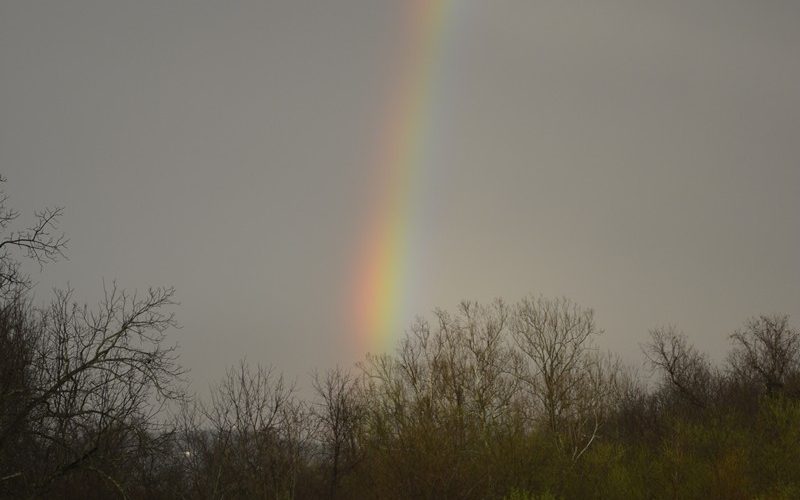
Staff Photo Amanda Bancroft
A double rainbow with lightning appeared south Fayetteville during recent storms. The second arc, less visible, typically has its colors reversed with red on the inside of the arc.
What do you call it when the sun shines while it’s raining? According to the 2003 Harvard Dialect Survey, the majority of people in the United States have no term for this phenomenon, but the most common term is a “sun shower.” Others say “the devil is beating his wife,” “the wolf is giving birth,” or liquid sun, pineapple rain, monkey wedding, and my favorite, fox wedding. Whatever you call it, these conditions are right for a rainbow!
Rainbows are formed when light is reflected, refracted, and dispersed through water droplets. The whole spectrum of color exists in a rainbow, but humans see just the famous seven: red, orange, yellow, green, blue, indigo, and violet (ROYGBIV). They don’t exist in a specific spot (sorry, pot of gold hunters) but are optical illusions formed in relation to a light source and the observer’s eye, which means we all see our own version of it. Not just rain, but mist, sea spray, fog, lawn sprinklers, waterfalls, and even dew can form rainbows. They always appear in the sky directly opposite from the sun.
There are various categories of rainbows, including: primary, multiple, twinned, full-circle, supernumerary, moonlight rainbows, fogbows, and higher-order rainbows. It’s possible to see rainbows at night via the light of a bright moon and water droplets from a variety of sources. Moonbows shouldn’t be confused with moon rings or 22 degree halos forming a complete circle around the moon with red color inside and blue color on the outside. Also called ice halos, these rings form whenever moonlight is refracted in ice crystals suspended in the atmosphere, and they’re an unreliable predictor of an approaching storm front.
In the double rainbow, the secondary arc (which is always seen above the primary) will appear faint and the color order reversed because the light has to go through two sides of each water droplet and is stretched across a greater distance of sky. But in twinned rainbows, the colors are not reversed: two distinct rainbows are being formed. A triple-split rainbow was photographed in Japan in 2012, showing three blurry arcs along with a fourth “secondary” bow! These are caused when droplets are different sizes. Supernumerary rainbows are also created by smaller droplets, usually in fog, and show a fainter band of fewer colors quite close to the violet end of the bow.
Monochrome (or red) rainbows are incredibly rare and look like a red band across the sky at either sunrise or sunset. Higher-order rainbows are hard to spot with the naked eye: the first photographs of a third-order rainbow were published in 2011, followed by the first pictures of fourth-order ones, and in 2014 the first fifth-order photos were taken. In a laboratory, 200th-order rainbows have been created! Scientists get into the math and study of rainbows much more deeply than this column, so explore what others have learned, then get outside and observe this wild world!
Amanda Bancroft is a writer, artist, and naturalist building an off-grid cottage for land conservation on Mt. Kessler. She and her husband Ryan blog about their adventures and offer a solar-hosted online educational center on how to make a difference with everyday choices at: www.RipplesBlog.org.










